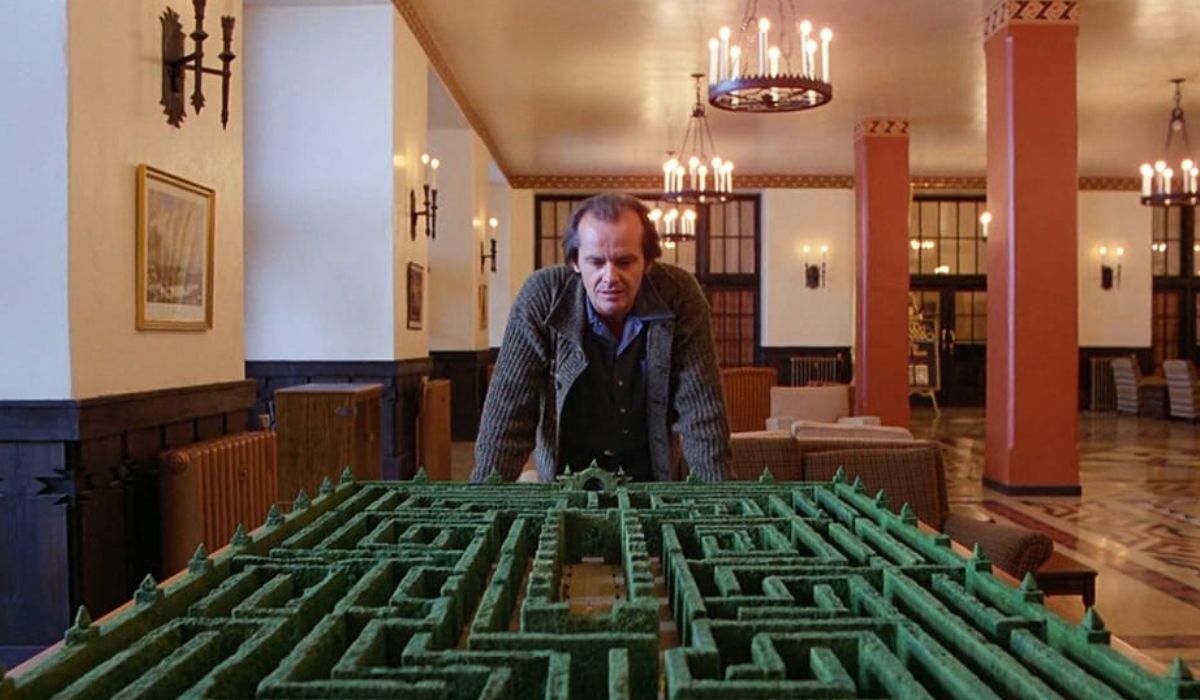
It’s common knowledge that Stanley Kubrick was renowned for his meticulous attention to detail and precision in his films, which is evident in every frame, camera movement, and edit – and this is certainly true for ‘The Shining‘. This iconic adaptation of Stephen King’s novel is brimming with striking visuals that have left an indelible mark on popular culture. From the endless corridors of the Overlook Hotel to the chilling twin girls, the blood-filled elevator, and Jack Nicholson’s unforgettable portrayal of a man wielding an axe through a door, Kubrick’s work in ‘The Shining’ is a testament to his artistic obsession.
Notably, one instance in “The Shining” that often goes unnoticed as a remarkable visual effects accomplishment is the scene featuring the model maze with Danny and Wendy strolling at its core.
The story unfolds approximately midway through the film, where Wendy (Shelley Duvall) and Danny (Danny Lloyd) venture into the genuine labyrinth of the hotel, leaving Jack (Nicholson) secluded and more erratic. As we watch Jack stroll through the grand lobby toward the full-scale model maze on a large table, the camera subtly draws closer to its core. Suddenly, it seems as if we’re observing an ordinary bird’s-eye view or zoom shot, but in truth, this is a skillfully designed visual deception – barely noticeable – orchestrated by a grandmaster of cinematic illusions. Remarkably, this effect was achieved without the aid of computer-generated imagery.

Instead of relying heavily on post-production visual effects like many directors of his era, Kubrick often opted for practical, on-set techniques as they lent a more authentic feel to his work. However, in this specific case, image compositing was essential – a technique that required meticulous planning and flawless execution, given its technological limitations at the time.
In simpler terms, the filming process shows us that the movie starts with a bird’s eye view of a miniature maze, filmed from six feet above. Afterward, a real-life version of the maze’s central part was built beside an apartment complex. Duvall and Lloyd were then filmed walking through this full-scale maze section, with the camera positioned on the roof, mimicking the same overhead angle. Finally, two separate shots were blended together using mask plates, a method used before green screens, which involves combining parts of one image onto another to create the impression that they are in the same location.
Essentially, what seems like one uninterrupted scene is actually two distinct parts skillfully merged together. This fusion is done so flawlessly that many viewers don’t even notice they’re watching a combination. The camera subtly leads the viewer’s gaze with a gentle zoom towards the subject, and as the figures come into view, the lighting, angle, and movement match up so precisely that it creates an almost perfect deception – a rarity for visual effects from that time period.
Why did Kubrick choose to film the maze in such detail rather than just capturing it from above? The explanation lies in the movie’s intricate symbolism. In fact, “The Shining” is rich with complex metaphors. The maze stands out as one of the key symbols: it mirrors Jack’s mental decline, patterns of violence, psychological confinement, and even the storyline itself, which features twists, repetition, and mirror-like elements. By depicting Wendy and Danny within the maze from a high, remote angle—as if they were small figures—the film creates an ambiguity about where the model ends and the real maze begins. In this way, Kubrick suggests that the characters are trapped within a carefully designed system, like subjects in an experiment. It’s no surprise that many scholars see the Overlook Hotel as a supernatural or metaphysical space.

From my perspective, this shot isn’t merely a technical feat; it’s a powerful narrative and aesthetic declaration that often goes unnoticed in discussions about the visual effects in ‘The Shining’. What makes it intriguing is its complexity, which contrasts starkly with the frequent focus on the groundbreaking Steadicam work, the blood-filled elevator scene (authentically created without CGI), or the ghostly makeup. However, the subtle and ingenious transition between model and full-scale maze deserves acknowledgment for its understated elegance.
Back in the day, when CGI was still a twinkle in someone’s eye, a movie like “The Shining” really stood out. It was a glimpse into an era where on-set magic was crafted with analog methods, precise planning, and directors like Kubrick’s unwavering dedication. What makes it fascinating is that the brilliance of these techniques often went unnoticed because they were so seamlessly executed.
It’s quite intriguing to see how this aspect echoes the movie’s overall layout. This element is consistently present throughout, yet it catches the eye only for those who care to scrutinize more deeply – a suitable parallel to the enigma that “The Shining” embodies itself.
The Shining is available to stream on Max.
Read More
- Gold Rate Forecast
- PI PREDICTION. PI cryptocurrency
- Rick and Morty Season 8: Release Date SHOCK!
- Discover Ryan Gosling & Emma Stone’s Hidden Movie Trilogy You Never Knew About!
- Masters Toronto 2025: Everything You Need to Know
- We Loved Both of These Classic Sci-Fi Films (But They’re Pretty Much the Same Movie)
- Mission: Impossible 8 Reveals Shocking Truth But Leaves Fans with Unanswered Questions!
- SteelSeries reveals new Arctis Nova 3 Wireless headset series for Xbox, PlayStation, Nintendo Switch, and PC
- Discover the New Psion Subclasses in D&D’s Latest Unearthed Arcana!
- Linkin Park Albums in Order: Full Tracklists and Secrets Revealed
2025-05-13 01:32